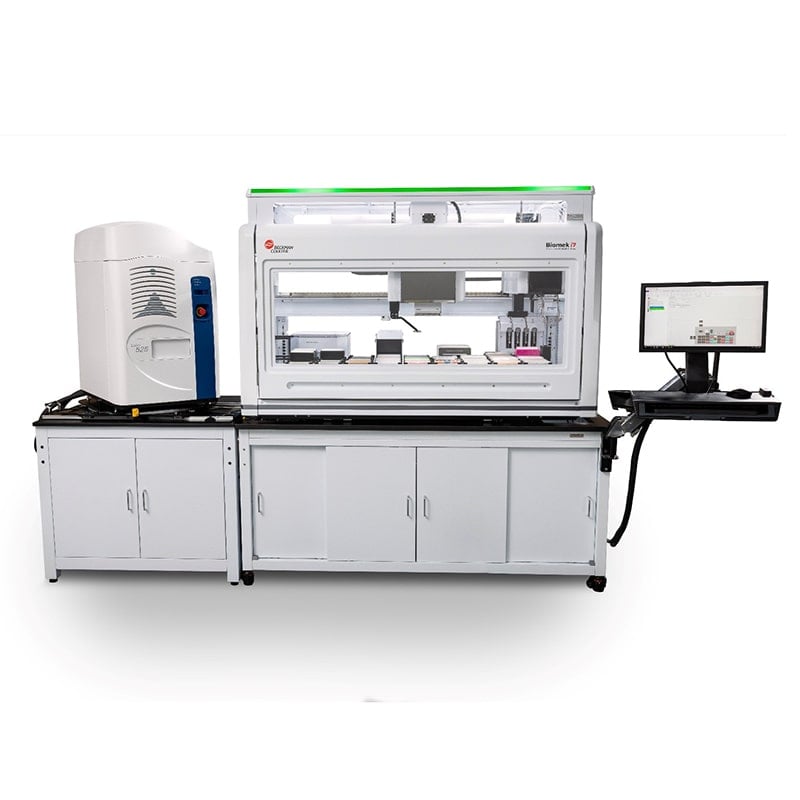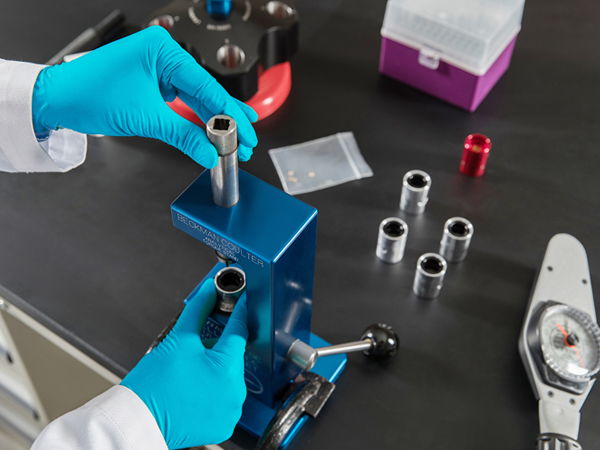mRNA Vaccine Technology: Development & Solutions
Following the discovery of mRNA in the 1960s, numerous attempts were made to harness its potential as a means of delivering therapeutics and proteins to the body, but progress was hindered by significant technical challenges, primarily due to the rapid degradation of mRNA and the need for an effective delivery method.1 Here we will explore the advanced tools used in mRNA vaccine development, highlighting their role in accelerating the discovery and production of effective vaccines.
mRNA Development Process
| Antigen Identification and Sequence Design | Plasmid Construction and Extraction | Plasmid Verification NGS | Expression Verification CFPS Reaction | IVT Reaction | mRNA Purification |
|---|---|---|---|---|---|
| Echo Acoustic Liquid Handler | |||||
| Genomics Extraction and Cleanup Reagents | |||||
| Biomek Echo One System | mRNA Extraction Reagents | ||||
| Biomek i-Series Automated Workstations | |||||
| BioLector XT Microbioreactor and Centrifuges | |||||
2. Plasmid Construction and Extraction
Echo Acoustic Liquid Handler
Genomics Extraction and Cleanup Reagents
Biomek Echo One System
Biomek i-Series Automated Workstations
3. Plasmid Verification NGS
Echo Acoustic Liquid Handler
Biomek i-Series Liquid Handlers
4. Expression Verification CFPS Reaction
Echo Acoustic Liquid Handler
Biomek i-Series Liquid Handlers
5. IVT Reaction
Echo Acoustic Liquid Handler
mRNA Extraction Reagents
BioLector XT Microbioreactor and Centrifuges
6. mRNA Purification
mRNA Extraction Reagents
Biomek i-Series Liquid Handlers
BioLector XT and Centrifuges
1. Antigen Identification and Sequence Optimization:
Antigen Identification and Sequence Optimization: Identifying and designing antigens for mRNA vaccine development and mRNA therapy relies on a combination of protein expression analysis (from viral components or cancer-related targets) and bioinformatics. In mRNA-related therapies, sequence optimization, including the addition of UTRs, a poly-A tail, and ARCA caps, is essential to protect mRNA from RNases and ensure efficient protein translation in vaccine and mRNA therapy development. Achieving this optimized mRNA sequence requires numerous iterative cycles, making accurate pDNA construction, expression, and sequence validation essential.
2. DNA Template Generation:
During development, a DNA template is created to guide mRNA and final antigen synthesis.
Plasmid Construct:
The Echo Liquid Handler, particularly the Echo 525, plays a pivotal role in the precise and efficient assembly of plasmid constructs.2 Its acoustic dispensing technology allows miniaturization of reactions, reducing reagent consumption and successful assembly of complex DNA constructs.3

We perform gene assemblies up to 93% faster using the
Echo 525 Acoustic Liquid Handler
Talk to an expert
The Biomek i-Series Automated Workstations complement this by handling larger volumes and automating subsequent steps in plasmid construction.4 The Biomek i-Series deck with integrated colony picking and with the integration of the Echo Liquid Handler can plate, grow and pick microbial colonies for plasmid production.
Plasmid Extraction
Obtaining high-quality plasmid DNA is crucial. Efficient plasmid purification is critical at this stage of the workflow. Using the CosMCPrep kit will ensure isolation of high-quality plasmids to be used in further downstream development. The Biomek i-Series Automated Workstations, when paired with the CosMCPrep kit offer a seamless and automated solution for walkaway plasmid extraction with increased throughput, consistency, purity, and reproducibility.
Beckman platforms can boost automated
plasmid purification throughput by 9.6X using
a
CosMCPrep kit
Talk to an expert

By pairing our extraction kits with our cleanup reagents further downstream, maximum product yield and quality can be obtained. Using AMPure XP for nucleic acid cleanup helps recover amplicons and remove contaminants that interfere with downstream analysis.
SPRI Bead-Based Reagent Workflow
STEP 1: BINDING

SPRI beads are directly added to sample reactions. In the presence of propietary buffer, nucleic acids bind to bead surface.
STEP 2: WASHING

A magnetic field is used to pull the microparticles out of solution. Contaminants are aspirated and microparticles are thoroughly washed.
STEP 3: ELUTION

Purified nucleic acids are easily eluted from the microparticles under aqueous conditions, which provides maximum flexibility for downstream applications.
3. DNA Template Verification (DNA Sequence and Protein Expression)
The DNA template is then verified via NGS and cell -free protein synthesis for expression accuracy and functionality.
NGS Plasmid Verification:
The Echo 525 Liquid Handler enhances NGS workflows through miniaturization and precise acoustic dispensing, significantly reducing reagent consumption and costs.5 By partnering with leading vendors such as seqWell, researchers can reduce costs for plasmid sequencing library prep to less than $4/sample. Biomek i-Series workstations complement this by handling larger volumes and providing flexibility in sample processing. These instruments together, as the Biomek Echo One System, streamline the plasmid construct process, from gene assembly to transformation, ensuring high throughput and accuracy.
Cell-Free Protein Synthesis (CFPS) Verification
Rapid validation of construct functionality through CFPS systems is accelerated by the Echo 525 Liquid Handler, enabling high-throughput, nanoliter-scale dispensing of reagents.6 This in vitro approach ensures that mRNA translates into functional proteins, validating therapeutic candidates. This is especially beneficial in enabling complex optimization involved in cell-free protein expression.
4. In Vitro Transcription (IVT): Synthesizing the mRNA
After DNA template linearization, mRNA is synthesized through in vitro transcription for optimizing conditions at a small scale to facilitate future scale-up. This step is critical, as it sets the stage for producing the mRNA that will ultimately encode the target antigen in cells.
IVT Reaction Setup
Biomek i-Series Automated Workstations automate IVT reaction7
setups on a larger scale, accurately dispensing reaction mixes, enzymes, and templates, ensuring reproducibility
and consistency across production batches.
Reaction parameters such as enzyme concentration, temperature, and nucleotide availability can be assessed using
BioLector XT Microbioreactor
microfluidics solutions. Nucleotide feeding and pH control throughout the mRNA production will enable researchers to fine-tune IVT efficiency, leading to enhanced transcription yield and quality.
Optimization with Acoustic Precision
Transcription (TX) and translation (TL), as crucial steps, can be evaluated at low volumes to determine the most efficient Design of Experiment (DOE). The Echo 525 Liquid Handler optimizes TX/TL reactions8 by rapidly testing multiple reaction conditions at nanoliter scales, conserving reagents, and identifying ideal reaction parameters.
mRNA Extraction
Following IVT, preparative centrifuges facilitate purification and isolation of proteins and plasmids, lipids and nucleic acids by rapid cell harvesting (up to 9 L in ~10 minutes). Preparative ultracentrifuges, in combination with density gradients, can be used to purify specific species of nucleic acid material on the basis of their mass or density, while the Optima AUC analytical ultracentrifuges are utilized for plasmid characterization (circular vs. non-circular forms) and protein structural analysis.
5. mRNA Purification: Ensuring Quality and Removing Impurities
Once mRNA is synthesized, it must be purified to ensure the quality and efficacy of the final mRNA product.
- Column-based purification and lithium chloride (LiCl) precipitation are two effective strategies for mRNA purification. mRNA purification can be achieved through lithium chloride precipitation with ethanol cleanup for high yields (though with limited removal of aberrant mRNAs) or chromatography-based methods for greater selectivity and scalability, with strict adherence to RNase-free conditions, optimized buffers and salts, controlled time and temperature, and manufacturing suitability, where all are critical in preserving mRNA integrity.
- Biomek i-Series Automated Workstations automate mRNA purification protocols, particularly magnetic bead-based cleanups; when used with mRNA extraction reagents it removes reaction byproducts and impurities, ensuring consistent purity, integrity, and quality of the synthesized mRNA products.
The purified mRNA is now ready for downstream processing, where it will be formulated into a vaccine. This workflow highlights the integration of advanced instruments like Echo Liquid Handler, Biomek i-Series Automated Workstations, Biomek Echo One System, BioLector XT Microbioreactor, CosMCPrep kit and mRNA extraction and cleanup reagents for development of next-generation mRNA -based therapies. The upstream processes discussed here are the foundation upon which the entire vaccine development pipeline rests.
Related Materials
References
- Johns Hopkins Bloomberg School of Public Health. The long history of mRNA vaccines [Internet]. 2021. Available from: https://publichealth.jhu.edu/2021/the-long-history-of-mrna-vaccines
- Bailey J, Lai J, Khan R, Lesnick J. Miniaturized multi-piece DNA assembly using Echo 525 [Internet]. Beckman Coulter Life Sciences. Available from: https://www.beckman.com/resources/reading-material/application-notes/miniaturized-multi-piece-dna-assembly-using-echo-525
- Bailey J, Lai J, Khan R, Lesnick J. Nanoliter-Scale DNA Assembly with the Echo 525 Liquid Handler [Internet]. Beckman Coulter Life Sciences. Available from: https://www.beckman.com/resources/reading-material/application-notes/nanoliter-scale-dna-assembly-with-the-echo-525-liquid-handler
- Cohen M, Randolph DE, Lozano ME, Anderson PW, Crissman J, Triana FJ, Cujec T. A fully automated high-throughput plasmid purification workstation for the generation of mammalian cell expression-quality DNA. SLAS Technol. 2022;27(4):227-236. doi:10.1016/j.slast.2022.01.005. Available from: https://www.sciencedirect.com/science/article/pii/S247263032200005X
- Kim JH, Duarte M, Lee H, Lesnick J. Optimized NGS library preparation with acoustic liquid handling [Internet]. Beckman Coulter Life Sciences. Available from: https://www.beckman.com/resources/reading-material/application-notes/optimized-ngs-library-preparation-with-acoustic-liquid-handling.
- Buss JA, Stoddard CD, Beck SV. Scaling down to scale up – Miniaturizing cell-free protein synthesis reactions with the Echo 525 Acoustic Liquid Handler [Internet]. 2023. Download here.
- Fang X, Evans K, Willis RC, Burrell A, Hoang Q, Xu W, Bounpheng M, Moturi S. High-throughput sample preparation from whole blood for gene expression analysis. SLAS Technol. 2006;11(6):381-386. doi:10.1016/j.jala.2006.10.001. Available from: https://www.sciencedirect.com/science/article/pii/S1535553506004552
- Bailey J, Eggenstein E, Lesnick J. Miniaturization and rapid processing of TXTL reactions with acoustic liquid handling [Internet]. Beckman Coulter. Available from: https://www.beckman.de/resources/reading-material/application-notes/miniaturization-rapid-processing-txtl-reactions-acoustic-liquid-handling.
ECHO is a trademark or registered trademark of Labcyte Inc. in the United States and other countries. Labcyte is a Beckman Coulter company.
Our Team is Ready to Help
Tell us a bit about yourself and what you would like to achieve.
Our experts will be in touch soon.













